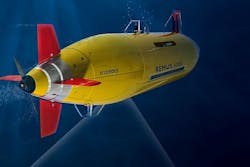DARPA asks industry for large unmanned undersea vehicle advanced payload delivery system
Officials of the U.S. Defense Advanced Research Projects Agency (DARPA) in Arlington, Va., issued a broad agency announcement (BAA) last week (HR001117S0022) for the Hunter program to develop a payload-delivery system from a large UUV. The Hunter program involves only the pay-load deliver system and not the extra-large UUV itself.
The Hunter Program is a 45-month program in three phases: the first to design and build the payload delivery device to fit inside a government-provided payload module; and the second and third phases to support integration of the payload delivery device into the big UUV for testing.
Technical details of the Hunter program are in classified documents that companies interested in participating must request.
Related: Navy taps Metron for advanced development of machine intelligence for UUV surveillance
Hunter phase 1 is in two parts: an 11-month project to design the Hunter system; and an 11-month option to build and test the payload delivery system. For now DARPA is asking for proposals to design and build the payload-delivery system, with cost estimates for the second and third phases.
DARPA officials say they may award Hunter phase-one awards to several companies, and will downselect to one company for the second and third phases.
U.S. military efforts to develop an extra-large UUV that could be suitable for a Hunter payload-delivery system are in progress separately from this solicitation.
Among the most prominent extra-large UUV projects involves the U.S. Office of Naval Research (ONR) in Arlington, Va., and the ONR Large Displacement Unmanned Undersea Vehicle (LDUUV).
Related: DARPA considers unmanned submersible mothership designed to deploy UAVs and UUVs
Several companies are involved in the LDUUV program, including Metron Inc. in Reston, Va., which is working machine intelligence; UUV designer Hydroid Inc. in Pocasset, Mass., which is developing an autonomy testing system for the LDUUV; and power and propulsion specialists Fuelcell Energy Inc. in Danbury, Conn.; Sierra Lobo Inc. in Fremont, Ohio; the Hamilton Sundstrand Corp. Sea Systems segment in Windsor Locks, Conn.; General Atomics in San Diego; Lynntech Inc. in College Station, Texas; and NexTech Materials Ltd. in Lewis Center, Ohio.
DARPA also is working separately on the Hydra program to develop an unmanned submersible to transport and deploy unmanned aerial vehicles (UAVs) and unmanned underwater vehicles (UUVs) stealthily close to enemy operations.
Companies interested should email requests for classified statements of work for the Hunter program at [email protected]. Companies interested should submit bids no later than 9 May 2017.
Email questions or concerns to [email protected]. More information is online at https://www.fbo.gov/spg/ODA/DARPA/CMO/HR001117S0022/listing.html.
Learn more: search the Aerospace & Defense Buyer's Guide for companies, new products, press releases, and videos
